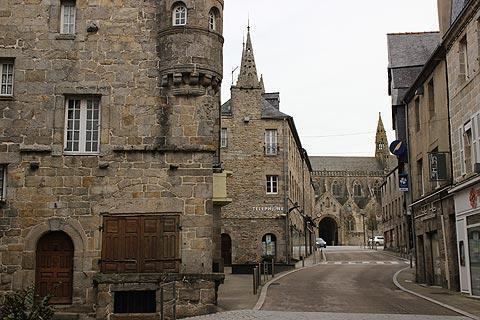Country France Area 23 km² | Intercommunality Pays Léonard Local time Wednesday 1:50 AM | |
 | ||
Weather 12°C, Wind S at 27 km/h, 87% Humidity | ||
Saint-Pol-de-Léon (Breton: Kastell-Paol) is a commune in the Finistère department in Brittany in north-western France, located on the coast.
Contents
- Map of 29250 Saint Pol de LC3A9on France
- Population
- History
- Gallo Roman walls
- 14th century
- Religious centre
- The Rvolution
- 19th and 20th centuries
- Sights
- Coast
- St Anne islet
- Breton language
- Personalities
- International relations
- References
Map of 29250 Saint-Pol-de-L%C3%A9on, France
It is noted for its 13th-century cathedral on the site of the original founded by Saint Paul Aurelian in the 6th century. It has kept a unique architecture, such as Notre-Dame du Kreisker Chapel, an 80 m high chapel, which is the highest in Brittany. It was also the scene of a battle during the Breton War of Succession, where the Montfortists and their English allies defeated an army led by Charles of Blois.
It is the largest vegetable producer and farmers market in Brittany responsible for 90% of French artichoke production and exports tens of thousands of vegetables to the whole of Europe every year.
Population
Inhabitants of Saint-Pol-de-Léon are called Saintpolitains.
History
The city takes its present name of one of the legendary founder saints of Brittany : Saint Paul Aurelian. The Latin name given to the entire region is now the Leon ("Pays Léonard"). It was long the seat of a bishop, now merged into the Roman Catholic Diocese of Quimper. The city later became a sort of religious capital.
Gallo-Roman walls
A double stone-alley, quite well preserved, is the last remains of prehistoric population on Saint Pol site. Several vestiges demonstrate a Roman military presence in the 3rd century. Based on ancient writings, Saint Pol would have then been enclosed by extraordinary high motted walls.
14th century
Battle of St Pol de Léon
Religious centre
As of the 6th century, the monastery site became an episcopate named "Kastell Paol". The city then extended beyond its walls. In the 15th century, Saint Pol de Léon is a famous spiritual and cultural centre. The Pempoul harbour is at its rise. Fortified doors protected the 2000 inhabitants until the 18th century. During the 18th century, the bishops of Léon strongly influenced the architectural style of the city. A new episcopal house was erected in 1706 and extended in 1750. The seminary dates from 1708, the catholic college from 1788.
The Révolution
During the Révolution the city lost the episcopate, a rich chapter, a college, 3 religious communities, a retirement house and 15 religious houses. Then started 100 years of economical decline. "Today Saint Pol de Léon is a dead city" was Flaubert's assessment in 1847.
19th and 20th centuries
As of 1883, the railway contributed to the considerable expansion of the agricultural production. In 1890 Saint Pol de Léon became the main commercial centre in France for vegetable exportation. Nowadays, the region is still the strongest concentration for horticultural production and transformation.
Sights
Coast
Scattered over 13 kilometres of coast line, some of the beaches, creeks and strands of St Pol de Léon have names of pieces of poetry : "Tahiti", le "Petit-Nice", "Sainte-Anne"… The walker discovers them from the panoramic viewpoint of the "Champ de la Rive" municipal park, which is overhung by a mission cross erected in 1901. The panorama is the most exceptional of the North-Finistère. All along the coast, a foot path will give you a unique view on the changing Channel, the Bloscon deep harbour of Roscoff, the Callot island with its chapel near Carantec. The boats, most of which of traditional construction, lie there awaiting for the flow to come. The sailing school at the end of the "Groue" pier proposes multiple sea activities for beginners or experienced users.
St. Anne islet
The Sainte-Anne islet a listed natural site and hermitage of the White Friars until the 18th century, the gigantic rock on the site, was once armed with cannons. Natural preserved site, where nothing remains of the chapel built in 1640. It is linked to the continent by natural bank of sand and pebbles, tarmacked in the 1970s. The "Groue" is the sediment strand which links the coast to the Sainte Anne island, forming the bay of Pempoul with its ashore harbour. The islet always played an essential role in the protection of the bay and the harbour of Pempoul.
Breton language
Personalities
Saint-Pol-de-Léon is the birthplace of :
International relations
Saint-Pol-de-Léon is twinned with
